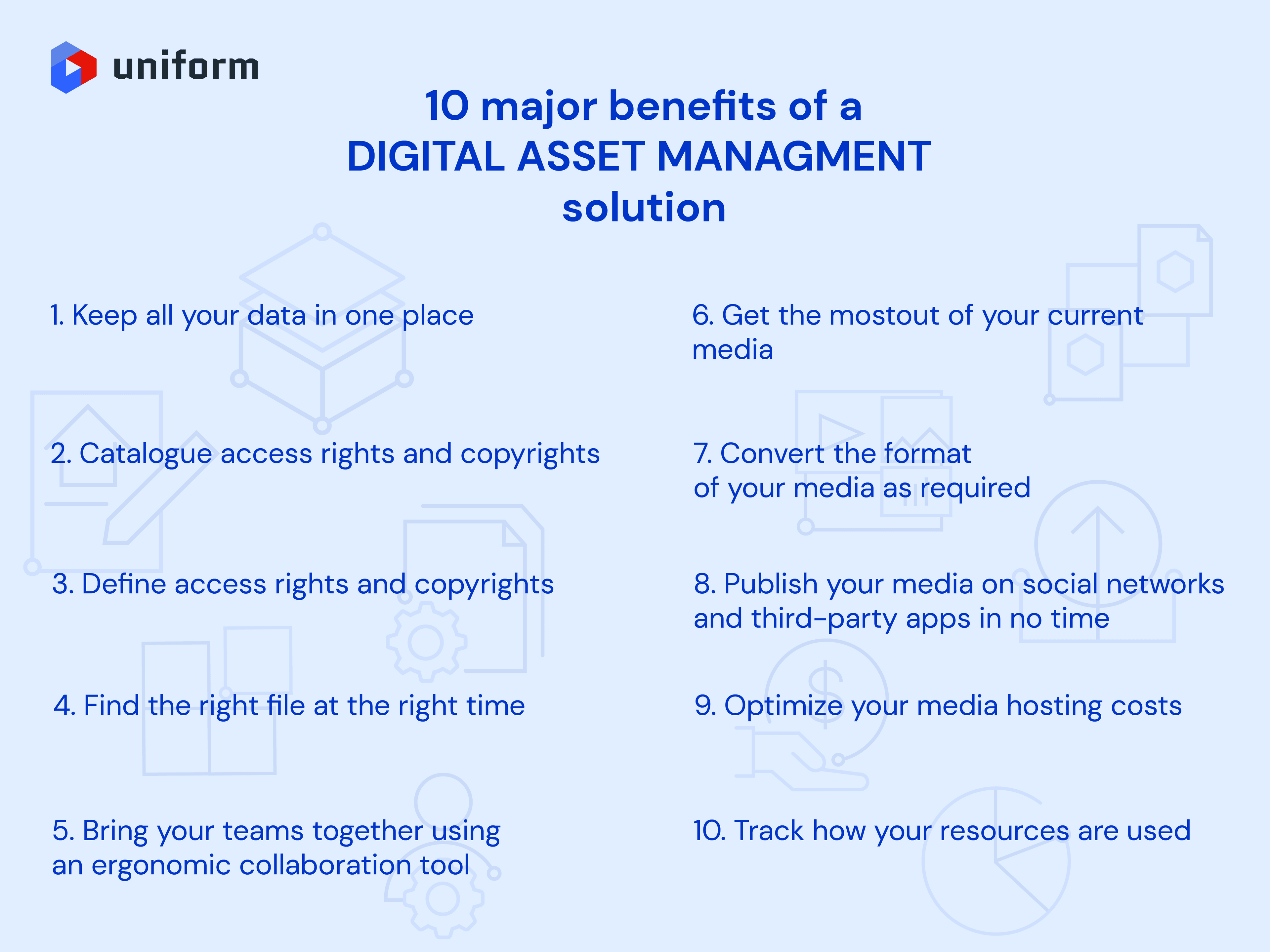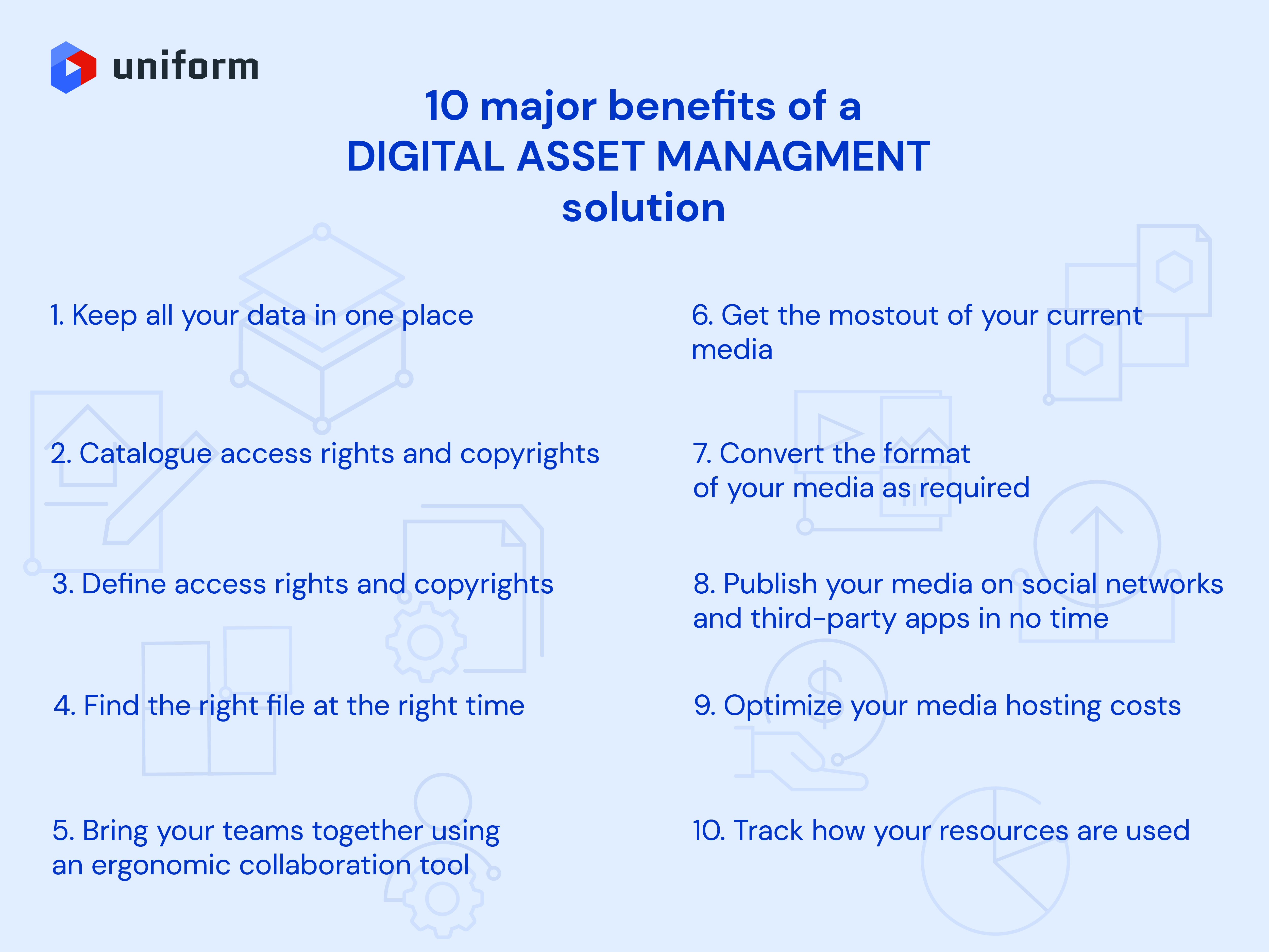Uniform blog/Benefits of digital asset management systems
Benefits of digital asset management systems
Benefits of digital asset management systems
Digital asset management (DAM) systems store brand assets in a central repository. By categorizing and tagging those assets for quick and easy search and access, you foster cross-team collaboration and ensure brand consistency. This post describes the benefits of DAM systems, which are invaluable for spurring workflows.

The seven gains
Adopting a DAM system and applying the best practices yields seven advantages.
1. Optimal organization of assets
As businesses grow, so do their creative library of assets like blogs, videos, and social posts generated by content and marketing teams. Properly handling and organizing those assets is key.
DAM systems store brand assets in a central place so that teams are on the same page, capable of retrieving them fast for content creation and branding tasks.
2. Smooth workflow and collaboration
Unbelievably, some major organizations still manually send and retrieve asset files, wasting time and causing confusion. In contrast, with a DAM system, teams can collaborate on the same project in real time by accessing files whenever they need them. Those responsible for editing and reviews can, for example, annotate documents with updates, which writers or designers can implement almost immediately.
As a result, important processes like content production, review of legal documents, and innovative creations such as product photoshoots are all streamlined.
3. Enhanced search and retrieval of assets
Once a file is in your DAM system, the author or uploader can enter the related metadata, such as the file type and owner. Additionally, you can develop a taxonomy and tagging structure to strategically label documents and link them to projects or departments. Standardizing file naming, metadata, and tagging ensures that you get the most out of your DAM system’s search capability.
4. Automated creation of assets
You can integrate your DAM system with the rest of your tech stack, e.g., the production, review, and orchestration tools, as well as the CMS. Afterwards, by syncing all your tools to pull only the camera-ready assets from your DAM system, you can seamlessly and consistently repurpose and distribute them to multiple channels.
For example, to update product photos for a brand, you upload the approved and finalized photos only once and—through integration with your other tools—dispatch those images to the product listings in channels like your website and mobile app.
5. Brand consistency
By virtue of one core “file cabinet” of branded assets, teams can stay on brand and avoid version-control headaches.
As for older documents—or those that don’t fit the current branding or messaging—you can tag them as retired or remove them from your system. Marketing directors and other managers can then rest assured that off-brand assets will no longer be in use, eliminating confusion or potential harm to your brand’s integrity.
6. Cost savings and higher ROI
Incorporating DAM systems into workflows saves costs and boosts ROI in several ways:
- You can furnish teams with analytics and tools to more efficiently manage content performance and repurpose the best-performing content.
- Storing and categorizing files in one place makes lost files and unnecessary overheads in time, energy, and expense spent in re-creating them a thing of the past.
- Efficiency in locating files is a tremendous boon, saving time and boosting productivity.
7. Reinforced security and data privacy
Most companies abide by the rule of least privilege when controlling file access, granting stakeholders that privilege to only what they need to do their job and nothing more. Managing permission controls that way through a DAM system significantly reduces the chance of mismanaging mission-critical data or assets.
With most DAM systems, managers or system admins can do the following:
- Set access permissions at the file level, restricting access to specific files to only authorized users.
- Set access permissions to documents as defined by a specific role. For example, a law firm might have different access levels for “paralegal” and “attorney” roles.
The effect of DAM on a composable approach
You can supercharge your DAM system by connecting it with your other tools. Uniform, the premier digital experience composition platform (DXCP) for all industries, brings together the entire tech stack, including your DAM system, to orchestrate consumer experiences. For details on those remarkable features, schedule a free demo with us.
DAM offers seven benefits:
- Optimal organization of assets
- Smooth workflow and collaboration
- Enhanced search and retrieval of assets
- Automated creation of assets
- Brand consistency
- Cost savings and higher ROI
- Reinforced security and data privacy








